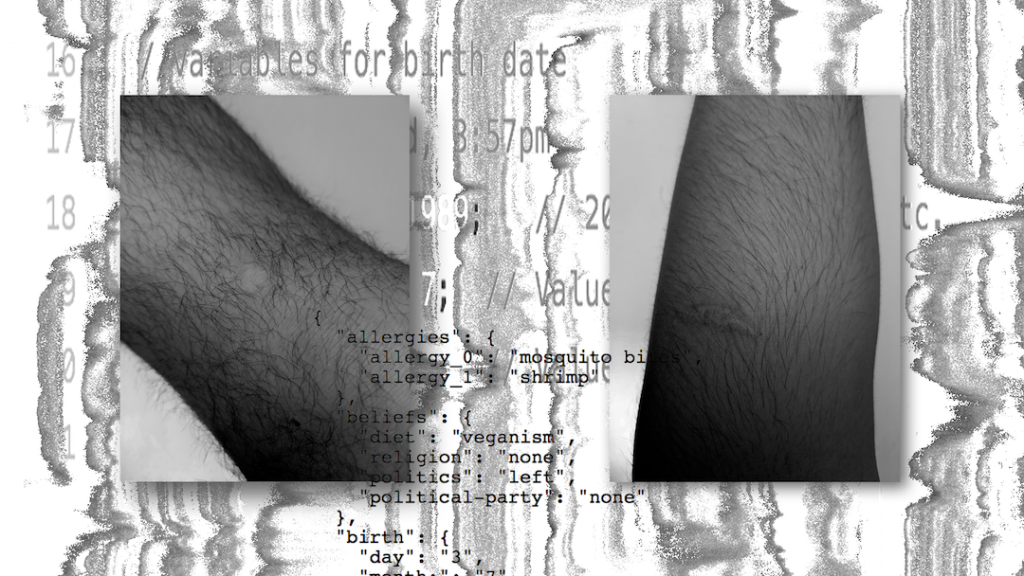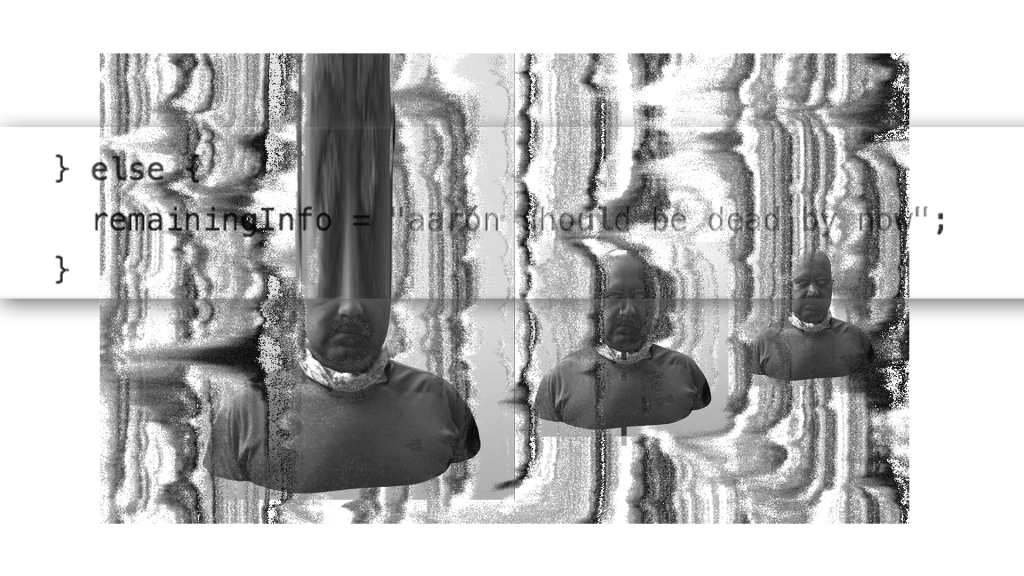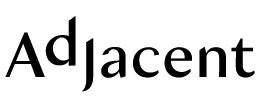Issue 4: Bodies and Borders
Self-Portrait in Open Source (Unfinished)

In this article I share my thinking process and results of my recent self-portraiture art pieces. While crafting these works, I reappropriated technological tools for art marking and created new ways of exploring my identity in public. As I logged my physical and emotional changes, opened myself to criticism, and expressed my passions, I underwent experiences of heightened and augmented vulnerability that have led to self reexamination, awareness and acceptance.
My name across multiple technologies
Hi, my name is Aarón. It is spelled with an ‘ó’, also known as ‘o-acute’ in English, ‘162’ in ASCII, and ‘ó’ in HTML. Databases and software are not perfect. Sometimes a glitch renders my name strangely and I receive emails saying “Dear Aarón…”
I was born in Chile, where we have two last names. My full legal name is Aarón Montoya Moraga. I have no middle name: Montoya is my father’s last name, and Moraga is my mother’s. This naming system reinforces a traditional and inequitable patriarchal social structure in which the father’s last name is prioritized and passed on to descendants. It also overlooks other family structures such as single-parent families and reinforces gender as a binary.
This two-last-name-model is also a bad interface for the modern English-based computer systems, which usually assume that my middle name is Montoya and that my last name is Moraga. To solve this, I started going by Aarón Montoya-Moraga and so far the only annoying by-product is that my last name takes too long to spell or write.
Names are an interface between our physical being and the outside analog and digital world, and just like any interface, it can help you, annoy you, mutate, and break.
Version control system portraiture
I’m on Facebook and Twitter. You can read my posts online for clues about who I am, my interests, and my affiliations. However, I might suggest that my GitHub account offers a more accurate and encompassing sense of who I am.
GitHub allows you to save your files in the cloud using Git, a version control system for tracking digital files as they evolve, by keeping detailed logs of their modifications. In Git jargon, a folder using Git to track its files is called a repository. As of today, I have nearly two hundred repositories online that store most of my work since late 2016.
You can download my files, read them, modify them, and execute them, without me ever knowing. You can browse apps and scripts I have written, websites I maintain, contributions I have made to friends’ projects. You also see the entire history of my contributions, with detailed logs of when and how much I worked on any project, including every error and rough draft I have saved. I try to save my work often, not hide my mistakes, and work mostly in the evenings and at night. This information is available for everyone to see.
Most of my projects involve long time spans, change focus over time and are code-heavy. I experiment with new approaches, develop tiny prototypes, and regularly break things. Git allow me to be vulnerable online and preserve the history of my work, including all of its shortcomings and failures. I am heavily inspired by open-source software and by artist Kyle McDonald’s “habit of sharing ideas and projects in public.” Sometimes I wonder if I am over-sharing, a question I’ve begun to examine more directly.
Project: transparency
transparency (2017-) is an art project that is both a web application and a public database. It is an ever-incomplete yet up-to-date record of my social, biological, medical, and cultural identity My goal is to update the record as often as I can and need, until I drop dead.

This project was inspired by the modern transparency portals inaugurated by governments and institutions that allow citizens and journalists to make these entities more accountable and less prone to corruption. It is also about biases embedded in building databases and software, which can lead to really bad stuff.
transparency‘s main asset is a file written using the JSON format, which stores my identity. You can access data such as my allergies, birthdate, educational background, current employer, scars, and even the drugs I have ever consumed. Up until last year, I had only had tried alcohol and caffeine, which I don’t regularly ingest. This year I tried marijuana, and I both updated this database and informed my family. That led to the disclosure of the existence of this database, this article, and a fun conversation about data privacy.
Starting September 2018, I also included pictures of my scars and my last blood test, including my glucose (normal), cholesterol (normal) and bilirubin (high) levels. My plan is to include more pictures about my body and more medical records, including my increasing myopia.

By far the most difficult section to address has been the parameters that interface with gender and sexuality. How can the precision and absolutism required by a database encode the complexity and fuzziness of these topics? Listing my parents as ‘mother’ and ‘father’ seemed to reinforce gender binaries, so for now they are listed as parent_0 and parent_1. But even this seems hierarchical and an unfair coding of my particular relationships with each of them. I used to have my genitalia listed, but friends pointed out that it too was reductive and reinforcing of a gender-binary, so I deleted it. I also went from using the male he/him/his pronouns to the gender-neutral they/them/their. This change was motivated by this project, the writing of this article, and by my journey down a rabbit hole researching gender.

transparency has become an exercise in addressing biases (I am writing in English and using digital mediums) and in trying to improve as a person and be accountable to myself, others and through time. It’s also about letting go, as in accepting that identity is dynamic and fluid, that all portrayals are biased, that we don’t have that much control of other people’s interpretations about us, and that their portrayals are as valid as ours.
Project: material-world
material-world (2018-) is another lifespan art project, focused specifically on my material possessions. It is made of several JSON files. To date it lists my books, instruments, and vinyls.

I am interested in sound art, comedy, politics, gender theory, computer music, electronics, signal processing, and education, so my record collection, the books I read, and the instruments I use are diverse. Because I, like most of us, am influenced by the media I consume, I embrace the idea of being open with the evolution of my taste and education.
Similar to transparency, this project requires me to be vulnerable. A person will inevitably construct their own impression of me from this data. It may fuel prejudices against me, or they may think I am being egocentric or boastful by sharing my wealth (represented by my possessions). Or someone may think I am pretentious or elitist by writing in English, which is not my native language. All data is measured from a particular point of view.
This project is a personal exploration about thinking about my possessions, my digital representation, and about my own interpretations of these things. Owning something doesn’t mean I adhere to it. I have read and owned several books that I no longer like, or gain meaning from, or find offensive. Even though these databases try to provide more data and insights about my identity, they are hard to contextualize. I constantly reevaluate their content and framing, and modify them.
Another instigation from these lifespan art database projects is empowerment. I decide when and how to release my personal information to the public. Of course, I know that corporations and governments already know most of my activities and preferences. My projects transform their databases from containing secret or privileged information to being mere duplicates of what I am already sharing. Having said that, they most surely have data about me that I don’t want to share without access and there is little I can do about that.
Next steps and final thoughts
The projects mentioned are works-in-progress and freely available for you to read, distribute, and modify. I would love to see new iterations of these works and to hear your thoughts about them. I also plan to teach fellow artists about databases: I am writing a JSON tutorial in Spanish and English, will teach workshops based on that.
A further project I am embarking on is a JavaScript package as a self-portrait. I already reserved montoyamoraga.js for this purpose. I want it to be used for installing me in web applications, and having functionalities such as querying for my current GPS location.
The research I did for these artworks has been highly transforming and educational, in particular Toward the queerest insurrection by Mary Nardini Gang. Even though I still have a lot to learn about gender, sexuality and politics, and rely on these other disciplines to continue finding better and more precise ways to express myself. Finally, below is a list of references I consulted, people I want to thank for their support, and a collection of projects that inspired me:
downloadmybody.com – Joe Mango and Matt Romein. A website for downloading the artists’ naked bodies.
keytweeter – Kyle McDonald. A yearlong performance where the artist tweets publicly their keystrokes on their computer.
Performing User – Lauren McCarthy. A class where I learned about performance art, technology, and being out of my comfort zone.
SharingInterviews – Kyle McDonald. A collection of interviews about creators sharing work, with an emphasis on open-source, media art, and digital communities.
Thoughts on total openness of information – Daniel Paluska. An essay about being, data and privacy
website with the sound of its own making – Emma Rae Norton. A project where you can listen to the sound made by the artist while creating the website.
whatisit.tech – Jen Kagan. A series of workshops for activists and people in technology who want to understand web technologies and the relationship between technology and contemporary social movements.
YOU.js – Sam Lavigne. A workshop about identity and JavaScript.
